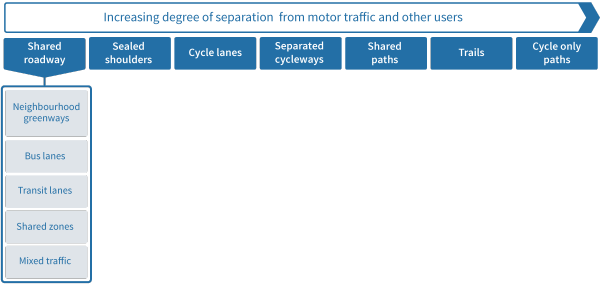There are a range of ways that cycling can be catered for between intersections. The diagram below shows the typology of different provisions for cycling, beginning on the left with those that are completely on-road where people who cycle share with other traffic to increasing separation from motor vehicle traffic. Cycle only paths involve the highest degree separation from other users as, unlike shared paths and trails, they are not shared with pedestrians.
Design of facilities between intersections generally requires consideration of road space allocation. It is important to ensure a facility, that is appropriate to a given road, can be accommodated within the space available.
Some routes may feature a range of facility types, it is important to consider the transition between them to ensure consistency of user experience.
The diagram below shows the type of facilities between intersection that are covered in the CNG:

Note that some cycle facilities can be provided as contra-flow cycleways, ie providing for cycling in the opposite direction to general traffic.
A shared roadway involves different types of general traffic lanes or zones that can be designed to accommodate cycling. This includes mixed traffic situations where cyclists travel side by side or in line with general traffic or subsets of motor traffic (eg buses or high occupancy vehicles) and zones of mixing that do not involve defined lanes.
The following shared roadway scenarios are distinguished in terms of traffic composition, speed and degree of mixing: